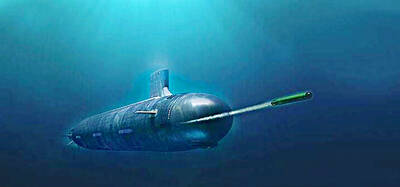The Philippine military yesterday said it plans to acquire the US Typhon missile system to protect its maritime interests, some of which overlap with regional power China.
The US Army deployed the mid-range missile system in the northern Philippines earlier this year for annual joint military exercises with its longtime ally, and left it there despite criticism by Beijing that it was destabilizing to Asia.
Since then, it has been used by Philippine forces to train for its operation.

Photo: Planet Labs Inc via Reuters
“It is planned to be acquired, because we see its feasibility and its functionality in our concept of archipelagic defence implementation,” Philippine Army Commanding General Roy Galido told a news conference.
“I’m happy to report to our fellow countrymen that your army is developing this capability for the interest of protecting our sovereignty,” he said, adding that the total number to be acquired would depend on “economics.”
The presence of the US missile launcher in the northern Philippines had angered Beijing, whose navy and coast guard forces have engaged in escalating confrontations over the past few months with the Philippines over disputed reefs and waters in the South China Sea.
Beijing claims almost the entire South China Sea despite an international ruling that its assertion has no legal basis.
As a rule, it takes at least two or more years for the Philippine military to acquire a new weapons system from the planning stage, Galido said, adding it was not yet budgeted for next year.
It took five years for Manila to take delivery of the BrahMos cruise missile last year, he added.
The land-based “mid-range capability” Typhon missile launcher, developed by US firm Lockheed Martin for the US Army, has a range of 480km, although a longer-range version is in development.
Galido said the Typhon system would enable the army to “project force” outwards up to 200 nautical miles (370km), which is the limit of the archipelago nation’s maritime entitlements under the UN Convention on the Law of the Sea.
“You have to take note of the fact that at 200 nautical miles there is no land there and the army cannot go there,” he said.
“We need to contribute to this [defense of Philippine interests] by having this platform to be able to assist the primary major service that would focus on maritime and air domain,” he added.
Under that scenario, the Typhon platform “will protect our floating assets,” he said, a reference to ships of the Philippine navy, coast guard and other vessel.
Chinese Minister of National Defense Dong Jun (董軍) in June said that the Typhon deployment was “severely damaging regional security and stability.”
Galido dismissed the criticism against the Typhon system in the Philippines.
“We should not be bothered by others’ seeming insecurities, because we don’t have any plans to go outside of our country’s interests,” he said.

FIREPOWER: On top of the torpedoes, the military would procure Kestrel II anti-tank weapons systems to replace aging license-produced M72 LAW launchers Taiwan is to receive US-made Mark 48 torpedoes and training simulators over the next three years, following delays that hampered the navy’s operational readiness, the Ministry of National Defense’s latest budget proposal showed. The navy next year would acquire four training simulator systems for the torpedoes and take receipt of 14 torpedoes in 2027 and 10 torpedoes in 2028, the ministry said in its budget for the next fiscal year. The torpedoes would almost certainly be utilized in the navy’s two upgraded Chien Lung-class submarines and the indigenously developed Hai Kun, should the attack sub successfully reach operational status. US President Donald Trump

TPP RALLY: The clashes occurred near the Chiang Kai-shek Memorial Hall on Saturday at a rally to mark the anniversary of a raid on former TPP chairman Ko Wen-je People who clashed with police at a Taiwan People’s Party (TPP) rally in Taipei on Saturday would be referred to prosecutors for investigation, said the Ministry of the Interior, which oversees the National Police Agency. Taipei police had collected evidence of obstruction of public officials and coercion by “disorderly” demonstrators, as well as contraventions of the Assembly and Parade Act (集會遊行法), the ministry said in a statement on Sunday. It added that amid the “severe pushing and jostling” by some demonstrators, eight police officers were injured, including one who was sent to hospital after losing consciousness, allegedly due to heat stroke. The Taipei

NO LIVERPOOL TRIP: Taiwan’s Lin Yu-ting, who won a gold medal in the boxing at the Paris Olympics, was embroiled in controversy about her gender at that event Taiwanese boxer Lin Yu-ting (林郁婷) will not attend this year’s World Boxing Championships in Liverpool, England, due to a lack of response regarding her sex tests from the organizer, World Boxing. The national boxing association on Monday said that it had submitted all required tests to World Boxing, but had not received a response as of Monday, the departure day for the championships. It said the decision for Lin to skip the championships was made to protect its athletes, ensuring they would not travel to the UK without a guarantee of participation. Lin, who won a gold medal in the women’s 57kg boxing

The US has revoked Taiwan Semiconductor Manufacturing Co’s (TSMC, 台積電) authorization to freely ship essential gear to its main Chinese chipmaking base, potentially curtailing its production capabilities at that older-generation facility. American officials recently informed TSMC of their decision to end the Taiwanese chipmaker’s so-called validated end user (VEU) status for its Nanjing site. The action mirrors steps the US took to revoke VEU designations for China facilities owned by Samsung Electronics Co and SK Hynix Inc. The waivers are set to expire in about four months. “TSMC has received notification from the US Government that our VEU authorization for TSMC Nanjing